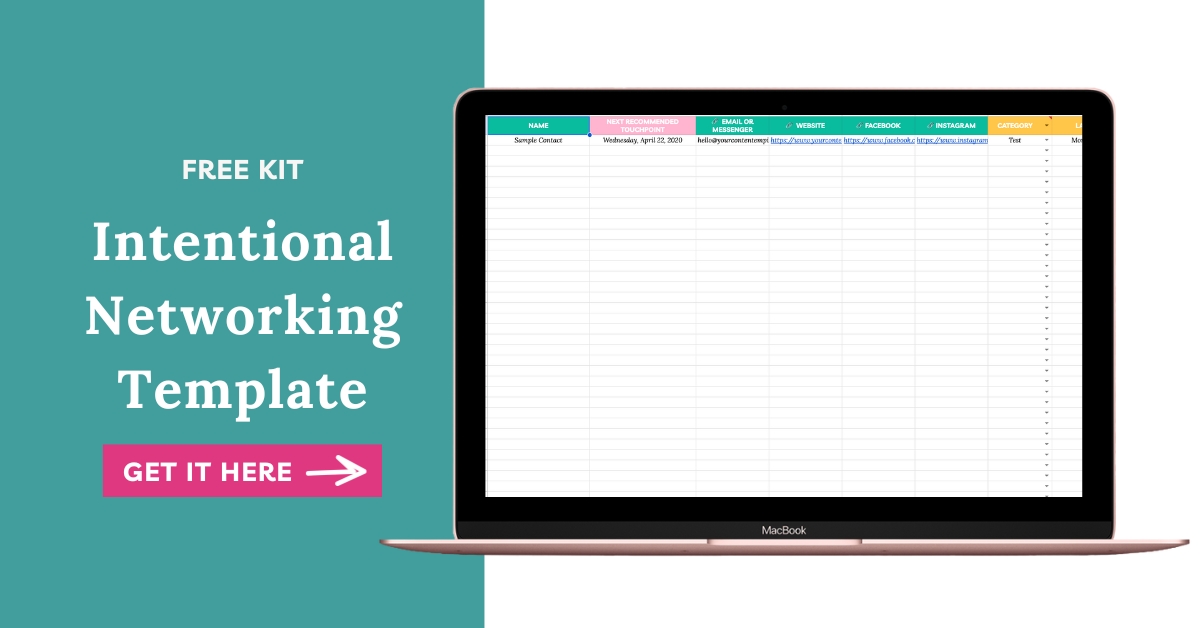As an introvert, building new relationships and networking does not come very naturally to me. I thrive when I am able to have one on one conversations and can hear about everything that you're up to.
I'm not the best at staying in touch. I spend a lot of my time in “head down mode” working on my own projects. By the time I remember to come up for air, it just seems like weeks have passed. The good news is that, as far as I'm concerned, we'll pick right back up from where we left off as if no time had passed at all.
I used to have a lot of shame about the fact that networking is such a struggle for me despite knowing it is something super important. I just couldn’t seem to master it, so I felt it was a shortcoming of mine. However, I've since talked to a lot of other business owners who feel the same as I do.
And so, I created a system that I have been using since the start of 2019. It finally convinced me that I can rock at networking, building relationships, and staying in touch with my business friends, clients, and customers–even as an introvert.
The Thing About Networking
I've learned two very important things about networking.
1) If you don't schedule it, it's never gonna happen. All relationships take work, and networking is no different. Take my marriage for example: If my husband and I don't have date night, we will just stop dating. It's the same way with your online relationships in that you need to create a regular routine around it so that they are something you can keep up with.
2) Networking is essential for us online business owners. I have had so many more opportunities come my way and so many more introductions to potential clients for my agency and courses. I've also been able to do the same for people in my network, and it feels awesome to be able to give back as much as I'm getting.
Todd Herman says, “Your business grows at the speed of relationships.”
Basically, if you are building your relationships, you're going to build your business. Your network will grow one relationship at a time and with that, your business will grow exponentially.
This guide is broken down into two parts. Part One is all about building your network and setting up the system. Part Two discusses what you’ll need to do in order to maintain your network system once you’ve set it up.
Part One – Building your Network
Step One: Have a regular networking time
Designate a time for doing your intentional networking. For me, I have an hour in the afternoon dedicated to staying in touch with business friends and connections, as well as checking in on my mastermind and paid programs. You may not need an hour; it's up to you.
Ask yourself: is this something you're going to do on a daily or weekly basis? Where does something like this fit into your business?
A lot of this is going to be based on your values and your priorities for this quarter, month, or year. If building a network and focusing on your relationships is a priority for you, then the amount of time and frequency that you dedicate to it should reflect that.
Now, if you're finding it hard to find time to create this networking time in your schedule, my recommendation is to start small and schedule. Maybe it's just 30 minutes once a week or daily. Once you’ve decided, put it in your calendar.
Step Two: Your Network Admin
The first step is to set up your networking spreadsheet or whatever tool you're going to use to track the people you want to stay in touch with. I have an intentional networking template that I created, which you can download below.
In one tab of the spreadsheet, I have my networking categories. Beforehand, you need to decide how to organize your network. Ask yourself, how am I going to classify people? Is it going to be past clients, businesses, friends, business besties, people that I’ve been in a mastermind with?
For the people in these categories, how frequently do you want to be in touch? I have a column here in my spreadsheet that basically says I want to get in touch every _ days. For example, for clients, past clients, and customers, I have 28 days written in to ensure that I'm popping in on and supporting them regularly.
Now, there is some code in the spreadsheet that calculates the day you need to stay in touch with them, so it's constantly giving you feedback on when to get in touch with these people on a certain day. But it's all based on the numbers that you assign.
Then I have this system linked up in Asana on my daily dashboard and it is something that pops up every single day. The task has all of the links and steps that I take for every time I complete this routine.
Step Three: Adding Your Connections to Your System
We want to go through the process of actually pulling everyone into this networking system. One of the big reasons why I've failed at networking in the past is that it felt like everyone was all over the place and I had no way of keeping them top of mind, especially when I got busy working on projects, other content that I was creating, and just with day-to-day life. This system is a way of having my contacts in one place, so that I can make sure I'm doing my part in supporting and staying in touch with them.
Even before you start using this system, dedicate that time to start gathering contacts. Another tip I recommend is to use those categories that you identified in step one. This step is all about gathering all of your contacts and their information, so that they're in one place. I have a few different columns ready in my spreadsheet, but you can add your own.
My Spreadsheet Columns:
I obviously want to know who I am talking about here and our next recommended touch point. In my spreadsheet, this is automatically calculated.
Next, we have email or messenger links. This is so that whether you are contacting people in Facebook Messenger or emailing them directly, you can put a link or their email address there to directly access it. Then, you have their website, Facebook, and Instagram; you can add other columns here for different things that you want to track.
Next is a drop down so you can select what category this contact is in and when your last touch point was. You want to put down this date so that the system will calculate the next time to contact them based on the frequency numbers you decided on in step two. I also have an area here for notes where you can track random facts about them such as if they have a launch coming up and their birthday.
Part 2 – Nurturing Your Network
So you've done all of the work of setting up your network and adding your connections all to one place. But we need to actually make sure you have a routine in place to make sure that you're actually using the system that you've set up. I don't know about you but I am notorious for setting up systems never sticking with them, so this part is a crucial component of building out an intentional networking practice.
I like to start by coming up with a checklist, because I never want to be guessing what I'm going to be using my hour of networking for.
Step 1 – Choose one social platform to focus on for the month
Whether that's Instagram, Facebook, or whatever platform you use regularly and where your people are, choose one platform and then dedicate time to it. In my own intentional networking time, here are some tips that I also use with my social media platforms.
One thing you can do to make staying in touch with people on Instagram easier is use the Instagram save feature. With it, you can essentially create lists of customers or clients and open them up to see what they've been up to, reply, and engage with them there.
For Facebook, say that I'm engaging in a certain number of groups and I want to be more present and show up as a leader to contribute. Maybe I just want to be a good community member. What I will do is save a bookmark folder with all of those groups that I want to play in on that day, open them up with one click, and go through each tab responding and engaging to different posts.
Step 2 – Go to the spreadsheet
I will go to my spreadsheet and I will look at my next recommended touch points. I will sort by that column and see who I need to be in touch with next and usually I will go and look at three of them. If there's more than that, I will get to them the next time.
And one of the tips here is, using the spreadsheet, you can open all of the columns and links for that particular contact at once with a Chrome extension called “Open Multiple URLs”. So if you're using Chrome, make sure to download that because it’ll help you streamline this process.
The key to making the most of this time is to have these little hacks and tips in place so that you're not spending your time hunting down and opening different links. We can make sure it's a really efficient process so that most of your time is spent on actually engaging with your network.
Step 3 – Anyone new to add?
Are there any new contacts or clients who have come into my circle that I want to get on my intentional networking spreadsheet? I want to make sure that I am constantly adding new people to that list, anyone that I genuinely want to stay in touch with.
Download the Intentional Networking Spreadsheet
That is my intentional networking system for online business owners, something that has really worked for me. I encourage you to sign up and download my intentional networking template below, so that you can start setting up your own intentional networking system.







